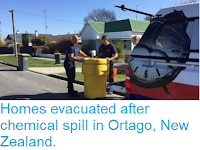Three men on a hunting trip were rescued alive after their campsite was hit by an avalanche early in the morning of Saturday 20 October 2018. The men were on an expedition trapping Stoats (a highly invasive European predatory species that presents a threat to New Zealand's native Birdlife) near Lake Te Anau in the Fiordland Region of South Island, New Zealand, when the avalanche hit, sweeping away the campsite, and leaving the men uninjured but very cold and wet (potentially life-threatening in a remote area without survival equipment), but were rescued after about an hour by a Southern Lakes Rescue Helicopter alerted to the event by an emergency beacon carried by the men.
Two of the hunters on a Stoat-trapping expedition that was later hit by an avalanche in Fiordland, New Zealand, on 20 October 2018. Ben Collins/Stuff.
Avalanches are caused by the mechanical failure of snowpacks; essentially when the weight of the snow above a certain point exceeds the carrying capacity of the snow at that point to support its weight. This can happen for two reasons, because more snow falls upslope, causing the weight to rise, or because snow begins to melt downslope, causing the carrying capacity to fall. Avalanches may also be triggered by other events, such as Earthquakes or rockfalls. Contrary to what is often seen in films and on television, avalanches are not usually triggered by loud noises. Because snow forms layers, with each layer typically occurring due to a different snowfall, and having different physical properties, multiple avalanches can occur at the same spot, with the failure of a weaker layer losing to the loss of the snow above it, but other layers below left in place - to potentially fail later. In this instance the avalanche appears to have been caused by rain falling onto snow covered slopes, weakening the structure of the snowpack.
Diagrammatic representation of an avalanche, showing how layering of snow contributes to these events. Expedition Earth.
Stoats, Mustela erminea, were introduced to New Zealand in the 1880s, in an attempt to control Rabbits, which had been introduced a decade earlier as a food animal and rapidly become an agricultural pest due to a lack of native predators, despite the warnings of scientists concerned about the effect that these alien predators would have on native Bird populations. Unfortunately these warnings proved to be accurate, and within six years dramatic population losses had been recorded in many species of New Zealand Birds. In an attempt to protect these Birds many species were established on offshore islands in the Fiordland area, though in the early 2000s Stoats were found to be reaching some of these islands, devastating the Bird populations there and leading to increased efforts to control Stoats in the Fiordland Region.
An introduced Stoat, Mustela erminea, with a Bird chick in New Zealand. Department of Conservation Te Papa Atawhai.
See also...
Follow Sciency Thoughts on Facebook.









